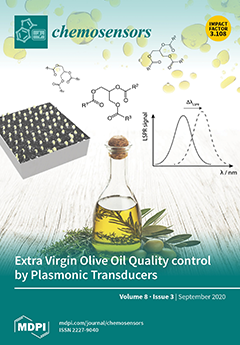NO
2-sensing properties of semiconductor gas sensors using porous In
2O
3 powders loaded with and without 0.5 wt% Au (Au/In
2O
3 and In
2O
3 sensors, respectively) were examined in wet air (70% relative humidity at 25
[...] Read more.
NO
2-sensing properties of semiconductor gas sensors using porous In
2O
3 powders loaded with and without 0.5 wt% Au (Au/In
2O
3 and In
2O
3 sensors, respectively) were examined in wet air (70% relative humidity at 25 °C). In addition, the effects of Au loading on the increased NO
2 response were discussed on the basis of NO
2 adsorption/desorption properties on the oxide surface. The NO
2 response of the Au/In
2O
3 sensor monotonically increased with a decrease in the operating temperature, and the Au/In
2O
3 sensor showed higher NO
2 responses than those of the In
2O
3 sensor at a temperature of 100 °C or lower. In addition, the response time of the Au/In
2O
3 sensor was much shorter than that of the In
2O
3 sensor at 30 °C. The analysis based on the Freundlich adsorption mechanism suggested that the Au loading increased the adsorption strength of NO
2 on the In
2O
3 surface. Moreover, the Au loading was also quite effective in decreasing the baseline resistance of the In
2O
3 sensor in wet air (i.e., increasing the number of free electrons in the In
2O
3), which resulted in an increase in the number of negatively charged NO
2 species on the In
2O
3 surface. The Au/In
2O
3 sensor showed high response to the low concentration of NO
2 (ratio of resistance in target gas to that in air: ca. 133 to 0.1 ppm) and excellent NO
2 selectivity against CO and ethanol, especially at 100 °C.
Full article





